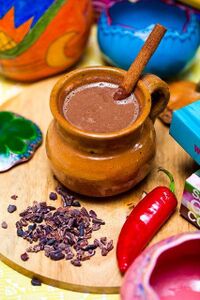Mutulese Chocolate: Difference between revisions
(Created page with "{{Region_icon_Ajax}} 200px|thumb|Kakaw ready to be presented for a [[Four Cardinal Beverages|Chocolate Ceremony]] '''Chocolate''', (Mutli: "Kak...") |
No edit summary |
||
| Line 1: | Line 1: | ||
{{Region_icon_Ajax}} | {{Region_icon_Ajax}} | ||
{{WIP}} | |||
[[File:Chocolate Maya.jpg|200px|thumb|Kakaw ready to be presented for a [[Four Cardinal Beverages|Chocolate Ceremony]]]] | [[File:Chocolate Maya.jpg|200px|thumb|Kakaw ready to be presented for a [[Four Cardinal Beverages|Chocolate Ceremony]]]] | ||
'''Chocolate''', ([[Mutli]]: "Kakaw") is produced all throughout the [[Mutul]], in quantities between 10,000 and 30,000 tons of {{wp|cacao}} and 9 - 10 millions of bottles per year. The Divine Kingdom is the largest producer of liquid chocolate in the [[Ajax|world]], and one of the two largest exporters of cacao alongside [[Sante Reze]]. Chocolate is almost cosubstantial with the country, as traces of chocolate beverages and vessels associated to its consommation can be found even in the oldest archeological sites. It is supposed that the cultivation of the {{wp|Theobroma cacao|cacao tree}} was brought north from the [[Sante Reze|Ucayare forest]] by nomadic populations of {{wp|Forestry|agro-forester}}. The chocolate produced range from expensive chocolates sold internationally to modest creations usually only seen within the Divine Kingdom. | '''Chocolate''', ([[Mutli]]: "Kakaw") is produced all throughout the [[Mutul]], in quantities between 10,000 and 30,000 tons of {{wp|cacao}} and 9 - 10 millions of bottles per year. The Divine Kingdom is the largest producer of liquid chocolate in the [[Ajax|world]], and one of the two largest exporters of cacao alongside [[Sante Reze]]. Chocolate is almost cosubstantial with the country, as traces of chocolate beverages and vessels associated to its consommation can be found even in the oldest archeological sites. It is supposed that the cultivation of the {{wp|Theobroma cacao|cacao tree}} was brought north from the [[Sante Reze|Ucayare forest]] by nomadic populations of {{wp|Forestry|agro-forester}}. The chocolate produced range from expensive chocolates sold internationally to modest creations usually only seen within the Divine Kingdom. | ||
Two concepts central to the better Mutuleses chocolates are the {{wp|terroir|k'ab}}, which links the style of the chocolate to the locations where the cacao are grown and transformed. The second is the ''Divine Mark'' that certifies the origin and the quality of the chocolate. The rules of the attribution of the Divine Mark closely define which cacao varieties and transformation practices are approved for classification in each of the Mutul's 75 000 exploitations. These rules only cover the production and distribution of liquid chocolate, chocolate tablets and "solid chocolate" do not show the same level of regulation, as they are not considered socially to be as prestigious. | Two concepts central to the better Mutuleses chocolates are the {{wp|terroir|k'ab}}, which links the style of the chocolate to the locations where the cacao are grown and transformed. The second is the ''Divine Mark'' that certifies the origin and the quality of the chocolate. The rules of the attribution of the Divine Mark closely define which cacao varieties and transformation practices are approved for classification in each of the Mutul's 75 000 exploitations. These rules only cover the production and distribution of liquid chocolate, chocolate tablets and "solid chocolate" do not show the same level of regulation, as they are not considered socially to be as prestigious. | ||
[[category:Mutul]] | |||
Revision as of 18:11, 27 July 2020
This article is incomplete because it is pending further input from participants, or it is a work-in-progress by one author. Please comment on this article's talk page to share your input, comments and questions. Note: To contribute to this article, you may need to seek help from the author(s) of this page. |

Chocolate, (Mutli: "Kakaw") is produced all throughout the Mutul, in quantities between 10,000 and 30,000 tons of cacao and 9 - 10 millions of bottles per year. The Divine Kingdom is the largest producer of liquid chocolate in the world, and one of the two largest exporters of cacao alongside Sante Reze. Chocolate is almost cosubstantial with the country, as traces of chocolate beverages and vessels associated to its consommation can be found even in the oldest archeological sites. It is supposed that the cultivation of the cacao tree was brought north from the Ucayare forest by nomadic populations of agro-forester. The chocolate produced range from expensive chocolates sold internationally to modest creations usually only seen within the Divine Kingdom.
Two concepts central to the better Mutuleses chocolates are the k'ab, which links the style of the chocolate to the locations where the cacao are grown and transformed. The second is the Divine Mark that certifies the origin and the quality of the chocolate. The rules of the attribution of the Divine Mark closely define which cacao varieties and transformation practices are approved for classification in each of the Mutul's 75 000 exploitations. These rules only cover the production and distribution of liquid chocolate, chocolate tablets and "solid chocolate" do not show the same level of regulation, as they are not considered socially to be as prestigious.